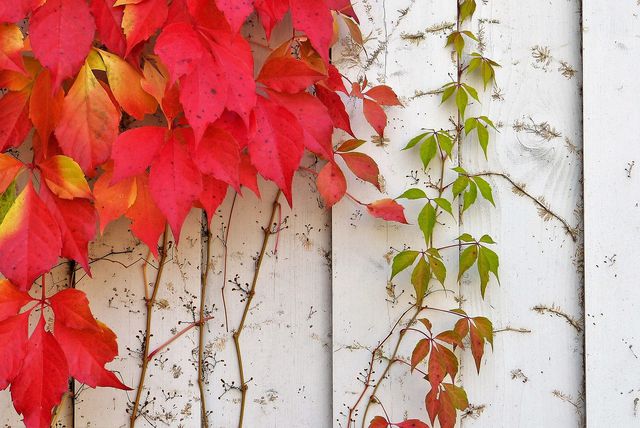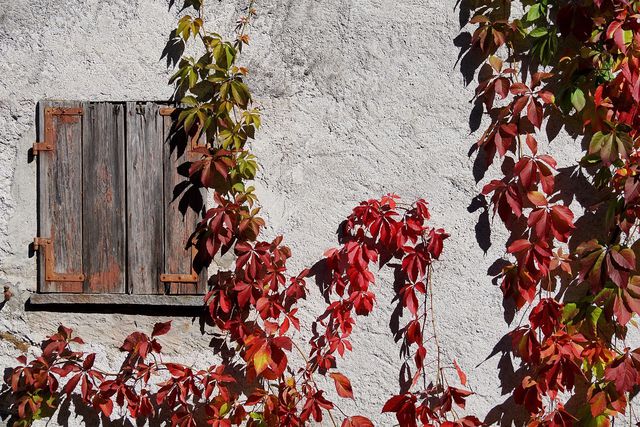Wild vine is a popular climbing plant that adds color to autumn with its glowing red leaves. We’ll show you what to consider when planting, pruning and caring for it.
Wild vine (botanical name: Parthenocissus) can also be found under the names maidenhair vine or fence vine. It belongs to the genus of grapevine and has about 13 different species. Originally, the plant comes from the temperate regions of Asia and North America.
Wild vine is a fast growing climbing plant. Each year it can grow a good two meters. You should therefore provide it with sufficient climbing space to develop to its full potential.
Wild vine is an excellent ornamental plant for planting on house walls, fences, posts and walls. You can also decorate your balcony with it.
Wild grapevine is especially beautiful in the fall, when its deep red carpet of leaves lights up the walls of entire houses.
Contents
Wild vine: a five-leaved or three-leaved variety?

Before you decide on a wild vine, you should take a closer look at your area to be planted. Depending on the planting area, the three- or five-leafed vine may be more suitable.
Wide walls: If you want to plant a wide area that is not very high, you should look at the three-leaf wild vine “Parthenocissus tricuspidata”. This, unlike its related species, often grows more in width than in height. In large areas, it sometimes grows twice as wide as it is tall. You can therefore plant it well along walls or flat house walls. The climbing plant usually does not need a climbing aid.
High walls: If you have a high surface, such as a classic house wall, the five-leaved species of wild vine are the better choice. For example, “Parthenocissus quinquejolia ‘Engelmannii'” is a widely used variety. Compared to its trifoliate relatives, this vine grows especially in height and less in width. “Parthenocissus quinquefolia” requires a climbing aid for planting, as it is less likely to adhere to masonry.
Both species are hardy and adaptable. The sunnier its location, the more beautiful its red foliage glows in the fall.
Planting wild vine: The best location for virgin vines

Once you have decided on a variety, you can now start planting. You can cultivate your wild vine all year round. In spring, however, it grows particularly quickly. Choose a humus-rich, loose and nutrient-rich soil for your vine. Also make sure that the soil never dries out.
Tip: If possible, always buy young wild vines in a sufficiently spacious plant container. This is the only way you can be sure that its roots have not been cut and that planting will really succeed.
Let’s go:
Dig a planting hole in a suitable, sufficiently sunny spot of your area to be planted. This should be about twice the size of the plant container of your young plant.
Mix your planting soil with enough homemade compost and two generous portions of organic complete fertilizer. Pour some of the potting soil into the planting hole.
Carefully lift your seedling out of the container with the previously watered soil and place it in the planting hole. Ideally, you should place it at a slight angle to the wall to make it easier for it to climb later.
Fill the hole with the remaining planting soil and tread it carefully. A small watering rim is good for supplying the young plant with sufficient water. Then water properly.
Depending on the type of vine, you should carefully guide the young shoots to their climbing support after planting and secure them if necessary.
Tip: Make sure that you do not plant several young plants too close together. This may produce denser growth in the first few months, but it will harm your wine in the long run: the plants will take up space from each other and will no longer find sufficient support on the wall with their support discs. Above a certain size, the laboriously grown leaf wall can then even tear off the surface completely.
Pruning Parthenocissus: Late summer is best suited

Wild vine should not grow without regular pruning. An uncontrolled growing vine can spread enormously and cause damage to the masonry. Before each planting, you should therefore also pay attention to any cracks on the wall surface and repair them in advance if necessary.
At the latest when your vine has reached the size to reach roof tiles, gutters or shutters, you should reach for the shears.
Pruning in late summer
You can prune your vine at any time of the year. Only during frost will you damage the plant.
However, late summer is ideal for major pruning.
You don’t have to be sparing with pruning and you can thin out generously. Wild grapevine tolerates pruning very well and sprouts all the more luxuriantly the following year.
Thin your vine to a maximum of the woody, thicker branches. These should not be pruned any further, as they form the trunk of your plant.
With good care and an ideal location, your wild vine can live 50 years or more.

